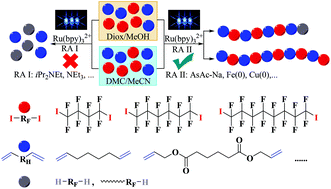Insight into the polymerization mechanism of photoinduced step transfer-addition & radical-termination (START) polymerizations†
Abstract
Photoinduced step transfer-addition & radical-termination (START) polymerization is a newly developed polymerization strategy for the preparation of perfluorocarbon-containing alternating copolymers and was carried out under irradiation with blue light emitting diodes (LEDs) at room temperature (25 °C). In this work, the polymerization efficiency was further enhanced through optimization of the solvent system and construction of an efficient catalytic system: Ru(bpy)3Cl2/reducing agent (RA). In dimethyl carbonate (DMC)/acetonitrile (MeCN), the polyaddition between α,ω-diiodoperfluoroalkanes A and α,ω-unconjugated dienes B predominated over the chain transfer reaction, generating the target polymer product (AB)n with a relatively high molecular weight. Detailed analyses of a template reaction revealed the intrinsic polymerization mechanism of the START process. Based on a comprehensive investigation of the polymerization process, guidelines for the selection of appropriate RAs (e.g., L(+)-ascorbic acid sodium salt (AsAc-Na) and Fe(0)) are provided herein.



 Please wait while we load your content...
Please wait while we load your content...